Indiana is home to many beautiful and unique plants, some of which are native to the state. If you’re looking for a way to add a touch of nature to your yard or garden, consider using native plants. Not only will they look good, but they’ll also be adapted to the local climate and soil, so they’ll require less work on your part. Here are just a few of Indiana’s stand-out native plants to get you started.
1. Purple Coneflower (Echinacea purpurea)
Purple coneflowers (Echinacea purpurea) are an amazing sight to behold! Not only do they boast a bright, vibrant hue of magenta, but the unique shape of their petals also makes them a stand-out choice for any garden.
The purple coneflower has been a beloved and trusted wildflower in Indiana for centuries. Beyond their beauty and vibrant appearance, purple coneflowers have a rich history in herbal medicine as well. Native Americans used the root of the plant to make various remedies to combat illnesses like digestive problems and pain. In addition, the flower petals and leaves have traditionally been used as an anti-inflammatory.
Standing tall and proud, it’s easy to spot the purple coneflower’s bright petals draping gracefully over its signature cone-shaped center, attracting bees and butterflies alike to its muted, sweet aroma.
A hardy perennial, this species does well in full sun or part shade, and it quickly re-establishes itself every spring. Plus, as an added bonus for plant lovers everywhere, it can easily be propagated from root divisions or seeds! So don’t forget to add this beautiful flower to your garden this season — your bees just might thank you.
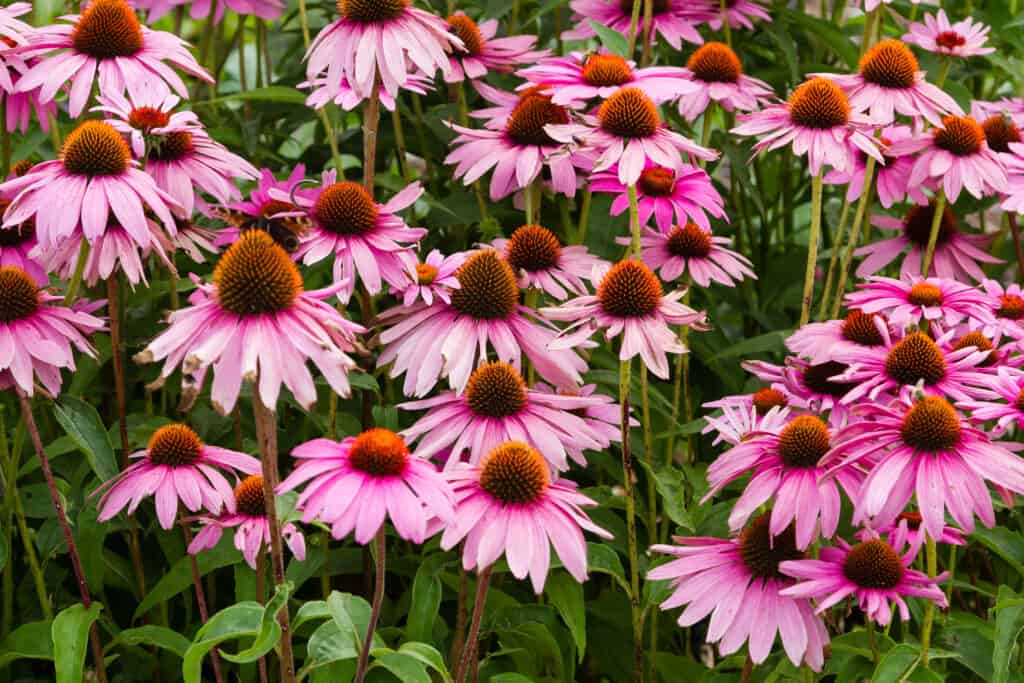
©Milosz Maslanka/Shutterstock.com
2. Rattlesnake Master (Eryngium yuccifolium)
Rattlesnake master, or Eryngium yuccifolium, are tall, beautiful plants that can grow up to six feet high. Native to many states, including Indiana, the plant is known for its fuzzy bluish-green stems and large umbels of beautiful flowers.
The plant’s name comes from a myth that rattlesnakes are repelled by it – however, scientists have not been able to confirm this.
Nevertheless, its flower heads make an excellent addition to a bouquet. Its medicinal properties continue to be studied by researchers who think it might be useful for treating issues like asthma, fevers, and even snake bites!
This hardy bloom puts up with hot and dry conditions making it perfect for dry areas of your garden. It has a unique texture and foliage, with deep green stems seemingly speckled with white dots! With long-lasting beauty, you will enjoy this flower from July to October, yielding clusters of unique flowery buds, some varieties will even yield blueish flowers.
The wind will bring a slight rattle from its serrations, mingling with the sweet aroma of the tiny blooms throughout the season — so don’t forget the rattlesnake master for an eye-catching plant that can survive most conditions and placements in your garden!
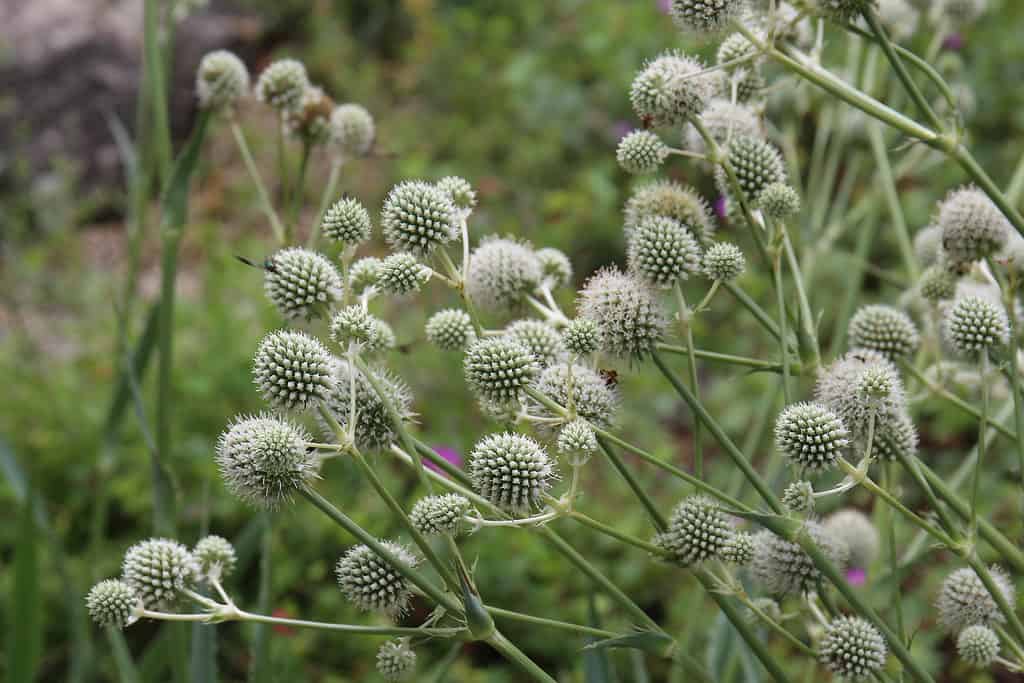
©Tracy Immordino/Shutterstock.com
3. Wild Columbine (Aquilegia canadensis)
The wild columbine, also known as the Aquilegia canadensis, is a perennial wildflower native to the US and Canada. It has distinctive red-and-yellow petals and many long spurs that make it stand out from the other members of its genus. Found mainly in woodlands and meadows, these plants stand between 12 to 36 inches tall, predominantly with striking reddish-purple flowers.
This flower blooms throughout the summer months, usually between May and August, making it one of the hardiest flowers in its class. Not only does the wild columbine add bright colors to its surrounding environment, but it is also an excellent source of nectar for local wildlife, such as pollinating birds and bees.
Though their seeds can be scattered to propagate these beautiful plants, many botanists opt to take gardening scissors or shears and gently clip the deadheads of already established blooms so they may continue delighting in their beauty throughout the growing season. The beauty of wild columbine makes it a worthwhile addition to any garden!
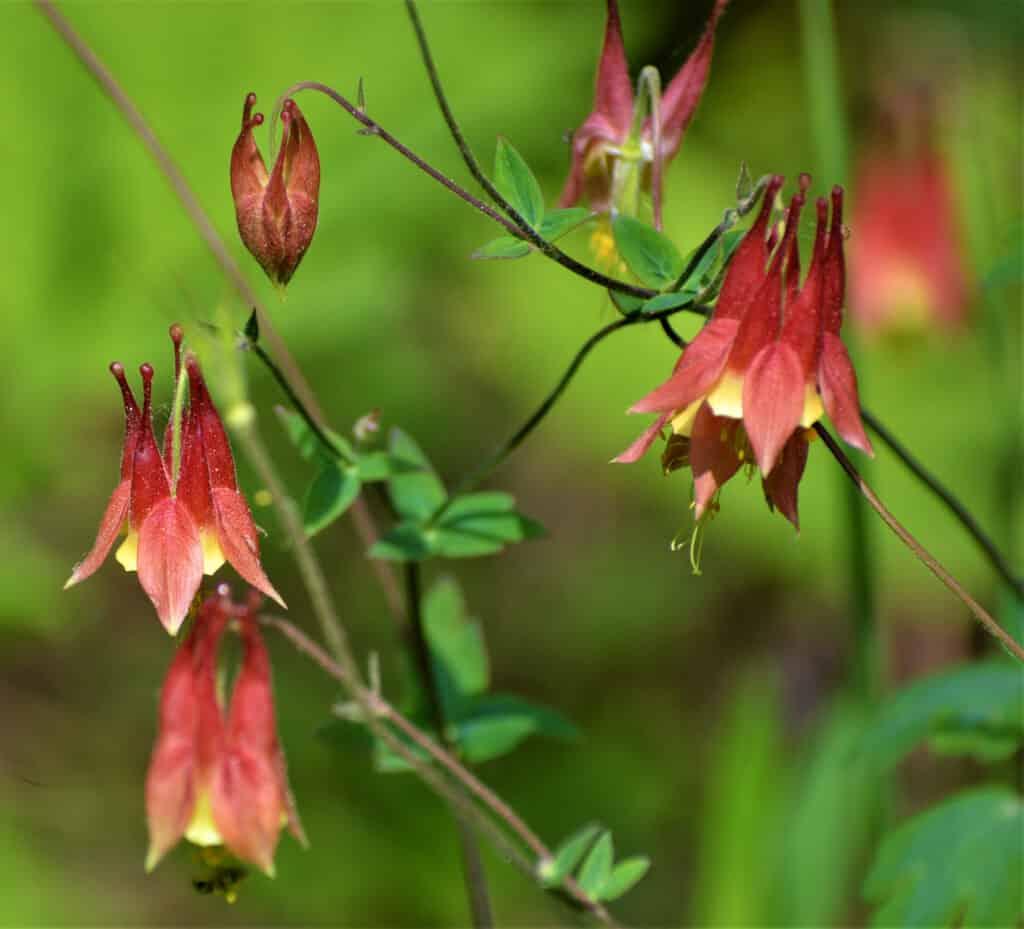
©akslocum/Shutterstock.com
4. Compass Plant (Silphium laciniatum)
The compass plant (Silphium laciniatum) is a stunning yellow flower that blooms in tall spikes and can reach up to seven feet tall! It’s called the compass plant because its large leaves have a North-South orientation—even in cloudy weather, you can use them to tell the cardinal directions.
The bloom season for the compass plant is typically from July to September. During this time, the plant produces large, yellow flowers that are about 6 inches in diameter.
To care for compass plants, it is important to provide them with full sun and well-draining soil. They are drought-tolerant and do not require frequent watering, but they appreciate occasional deep watering during dry periods.
Did you know American settlers and Native Americans used these compass plants for food and medicine?
The waxy stems of the plant contain an abundance of sap, which was once harvested for wax and candies and is still used today as a flavoring agent or additive. In addition, its flowers were used to make cough syrups, decoctions, ointments, and salves. This unique plant is one more example of how nature offers us such a variety of valuable gifts!

©meunierd/Shutterstock.com
5. Trumpet Honeysuckle (Lonicera sempervirens)
Trumpet honeysuckle (Lonicera sempervirens) is an incredibly fragrant flowering vine that is native to the larger part of North America. Its vibrant flowers bloom from late spring through early summer and bring with them a delightful sweet smell.
Often sprouting orange-red flowers during certain parts of the year, the trumpet honeysuckle is an incredibly hardy species that has adapted to various climates. As such, it can be found growing in many parts of the world, from backyards to parks and beyond.
The trumpet honeysuckle is often used in trellises, arbors, and pergolas, providing support for its vining growth habit, but it can also be grown as an informal hedge or pruned into an espalier shape against a wall or fence.
While most trumpet honeysuckle blooms are red or orange, new cultivars have been developed that produce flowers in shades of lavender, pink, and yellow. It’s no wonder this easy-care plant has become so popular. Its vibrant blossoms attract butterflies and hummingbirds alike, making it a great addition to any garden.
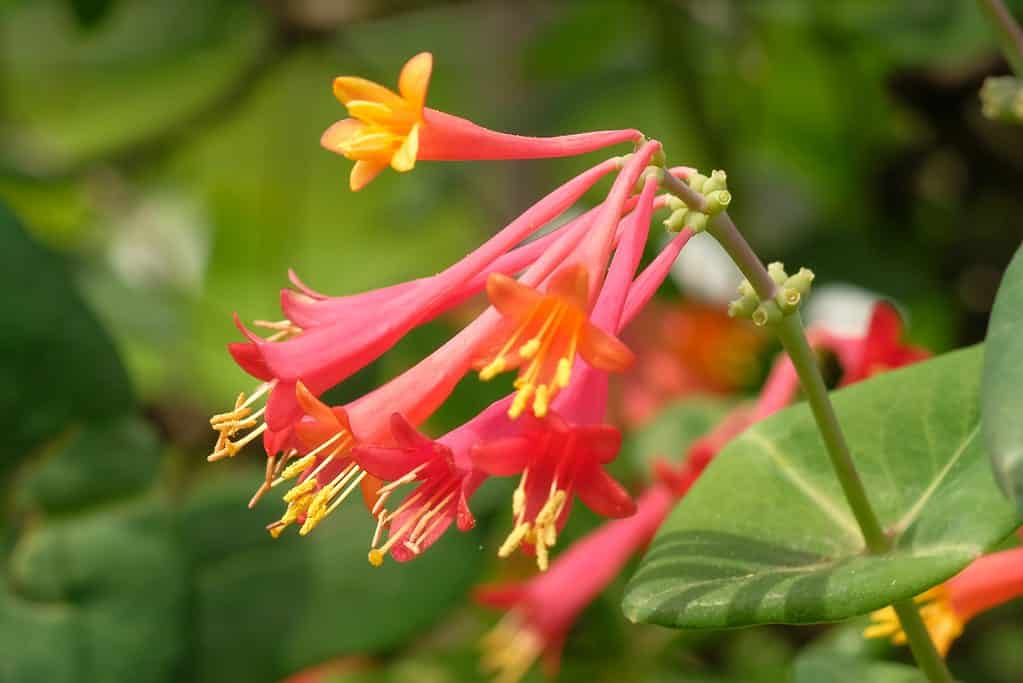
6. Indian Grass (Sorghastrum nutans)
How can we forget Indian grass (Sorghastrum nutans) while talking about the native plants of Indiana? Indian grass is a tall perennial grass native to the United States, primarily inhabiting dry meadows and prairies.
This ornamental grass grows best in full sun and can reach 4-6 feet in height, with striking purplish seed heads. Its unique blue-green foliage turns red in the fall, providing a splash of color just when one expects plant life to be on its way out for the season.
Indian grass is exceptionally hardy and is easily adaptable to most soil types; however, the soil should be well-drained for optimal results. It needs little maintenance once established, as it resists drought, pests, and diseases quite well.
Its blue-green foliage is fragrant when rubbed between fingers – a great way to attract wildlife to your garden area! Whether planted as an isolated specimen or in large groups, Indian grass makes an elegant and eye-catching addition to any landscape. Indian grass certainly lives up to its reputation as one of the most reliable members of the prairie grass family!
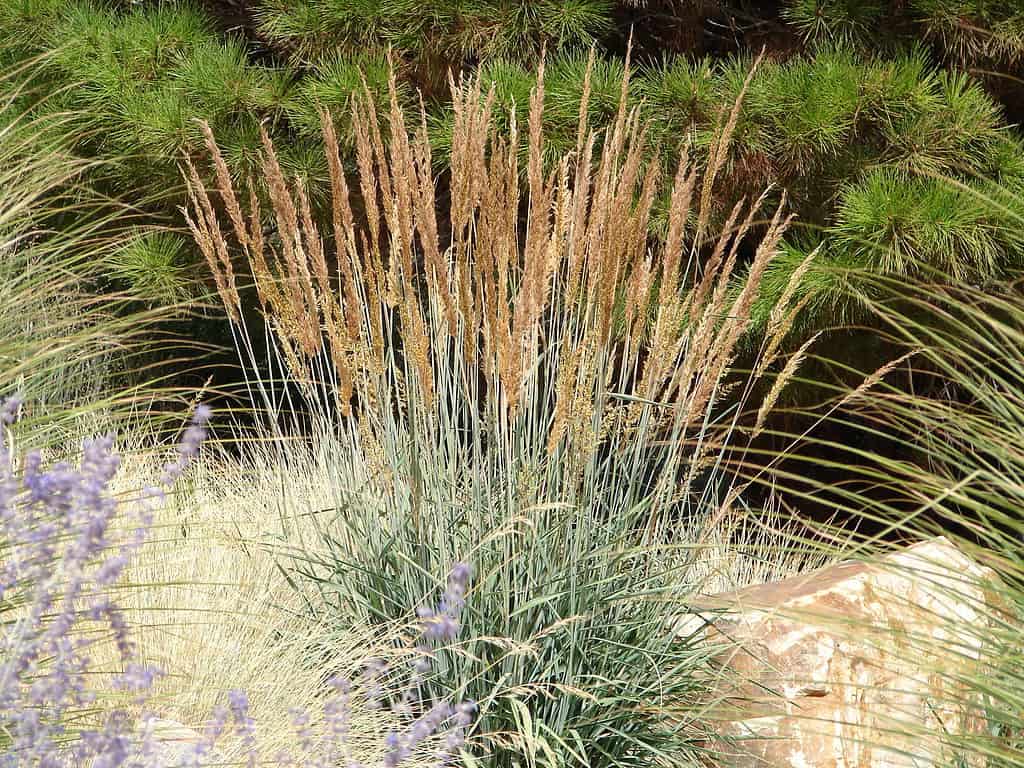
©Kathryn Roach/Shutterstock.com
7. Spicebush (Lindera benzoin)
Spicebush (Lindera benzoin) is a native shrub of Indiana with many uses. It’s an evergreen, meaning its glossy dark green foliage stays vibrant all year round. As one of the first plants to bloom in spring, spicebush produces tiny but fragrant yellow flowers that are a harbinger of the coming season.
In the summer, its aromatic berries mature, making it possible to turn this wild shrub into tasty dishes with a citrus-like flavor.
Even if you’re not planning on cooking with spicebush yourself, it’s a great addition to any garden or nature area due to its easy maintenance.
Spicebush typically grows to a height of 6-12 feet. However, it can sometimes reach heights of up to 15 feet. The shrub has a rounded shape and is covered in small, oval-shaped leaves that are about 2-4 inches long. In terms of maintenance, spicebush generally requires little pruning or other care. But with that said, it can benefit from occasional fertilization in the spring.
Not only will spicebush make your yard smell great, but the leaves and twigs can also be used to make tea! Furthermore, if you have a wildlife garden, spicebush is an excellent nectar source and could be used by several species of butterflies or moths. Even further, the fiery red berries in fall give lovely color during the fall months.
So if you’re looking for an easy-to-care-for shrub with multiple uses and benefits, spicebush is worth considering!
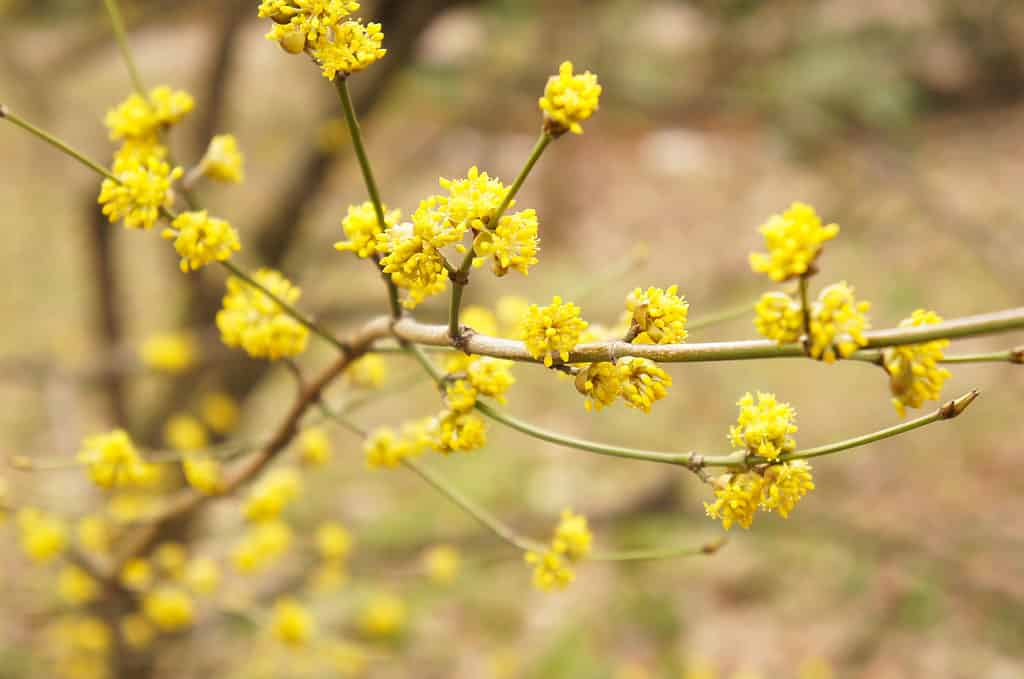
©mizy/Shutterstock.com
8. Wild Ginger (Asarum canadense)
Not to be confused with the ginger spice Zingiber officinale, wild ginger is a delightful flower found throughout Canada and the United States, often in wooded areas. Its blooms are deep burgundy in color and bring any garden or outdoor space to life with the infusion of vibrant color.
Wild ginger’s most attractive feature is its heart-shaped foliage, which can be found in both green and bronze tones and adds a beautiful touch to your home or garden.
Wild ginger is a low-growing herbaceous plant that typically reaches a height of 6-8 inches. Leaves are about 2-4 inches long and produce small, inconspicuous flowers in the spring. Dark brown or blackberries follow these flowers in the fall.
Wild ginger can even be eaten for adventurous types – it’s delicious in salads.
An interesting fact about this plant is that it spreads using an underground rhizome, enabling it to survive harsh conditions while also forming beautiful patches covering large areas when left unmaintained. Wild ginger may not be as showy as some other plants, but it is undoubtedly gorgeous due to its striking blooms and unique foliage!
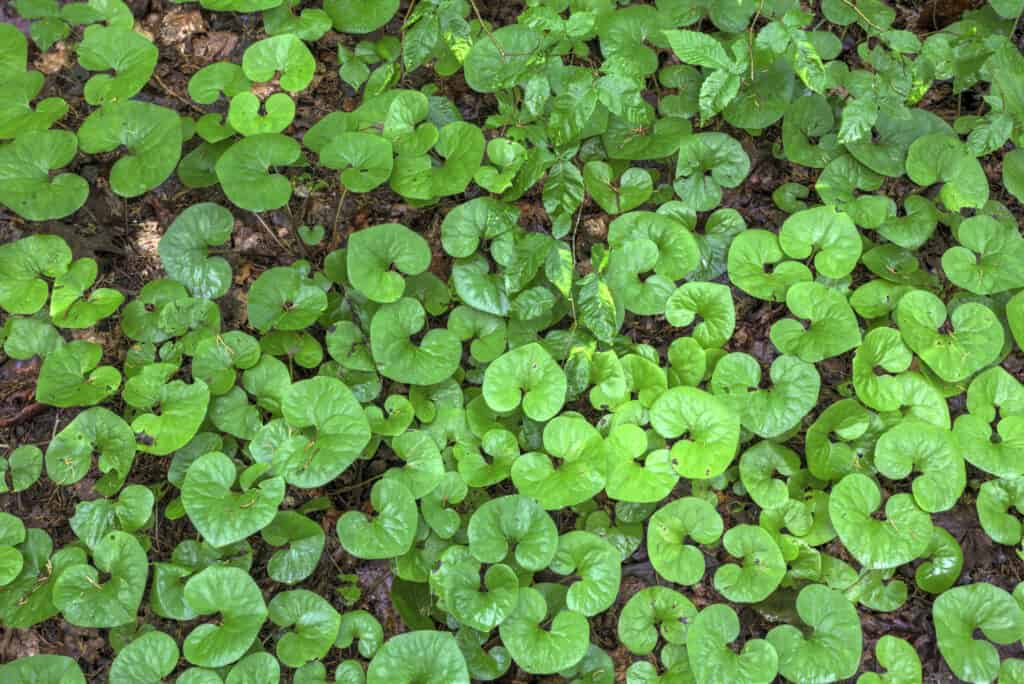
©iStock.com/CarbonBrain
9. Aromatic Aster (Aster oblongifolius)
The last on our list is aromatic aster. With its bright daisy-like flowers and unique aroma, aromatic aster can add undeniable beauty to any outdoor space. Aside from being beautiful, this species of aster is also quite interesting. Although it has become naturalized across many parts of North America since it was brought over from Europe, its true origin is still widely debated.
This wildflower has thick, serrated leaves that make a delightful contrast when lined up among their bright purple blooms. The vibrant colors of this plant attract butterflies and bees alike, enlivening gardens from late summer through fall.
Plus, it’s a fragrant shrub – gardeners can take a whiff of its spicy scent as they pass by!
This aster prefers moist soils in part sun or light shade areas and will grow 1-3 feet tall, depending on the conditions. It typically blooms anytime between late summer and early fall and can attract various wildlife.
To maintain aromatic aster, it is crucial to provide it with the right growing conditions. The plant prefers full sun to partial shade and well-draining, fertile soil. It is also tolerant of a range of soil pH levels, from acidic to alkaline.
The aromatic aster does not require frequent watering. It is drought-tolerant and can tolerate occasional dry spells. However, it will benefit from occasional deep watering during extended periods of drought.
For those looking to create an interesting landscape with some wonderful aromatic features, aromatic aster is definitely worth considering!

©anna kadoglu/Shutterstock.com
Up Next
The post 9 Native Plants in Indiana appeared first on AZ Animals.
from Animal News, Facts, Rankings, and More! - AZ Animals https://ift.tt/MdETuXC